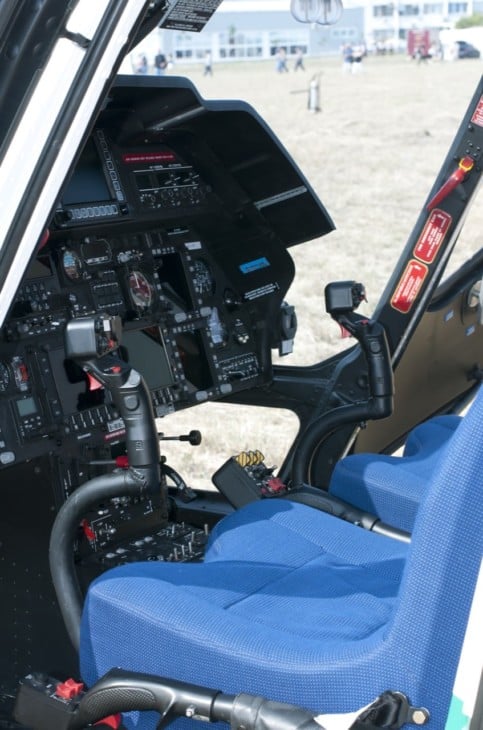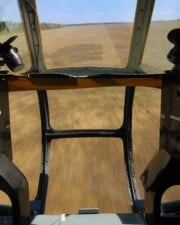Commercial airlines are equipped with autopilot systems, allowing for safe flight without continuous manual control from the pilots. The first autopilots were developed in 1912 and used commercially as early as the 1920s. This leads many people to wonder whether helicopters have autopilot.
Table of Contents
TLDR – Some modern helicopters are equipped with autopilot systems that allow the rotorcraft to automatically hover in place. However, helicopters are inherently less stable compared to airplanes, which restricts the ability of the autopilot system to completely control flight.
How Does Helicopter Autopilot Work?
There are several types of autopilot systems used in modern helicopters, including digital flight guidance systems (DFGS) and digital flight control systems (DFCS). These systems may control one or two elements of flight or provide complete hands-off operation.
At the base of these systems is the flight director (FD). The FD obtains raw data related to altitude, air data, and course. It then computes steering commands based on the desired position and current position.
The most basic autopilot systems provide increased stability but do not completely fly the helicopter. For example, the system may provide stabilization for the pitch, roll, and yaw of the helicopter’s flight.
The yaw damper is used to reduce the rolling and oscillations that occur during flight. The damper limits the fishtailing effect, providing a more stable flight.
Some autopilot systems may also include a stability augmentation system (SAS). A SAS provides short-term altitude stabilization. It minimizes the impact of outside disturbances, allowing the pilot to retain greater control of the helicopter’s movement.
For example, when the SAS detects a strong wind gust, a stabilizing control signal is sent to the necessary actuators to level out the flight of the helicopter.
Autopilot systems for helicopters are categorized based on the number of elements that they control. The most basic option is the single-axis autopilot, which simply keeps the helicopter from rolling.
A two-axis autopilot system controls the roll and pitch of the helicopter. A three-axis autopilot controls the yaw of the helicopter. The four-axis autopilot introduces an automatic hover feature.
What Does HOV Stand for in a Helicopter?
The “HOV” in a helicopter stands for automatic hover. It is included in automatic flight control systems (AFCS) that offer four-axis control.
Operating a helicopter requires the pilot to use three main control systems. The pilot uses the collective stick to control the amount of lift generated by the main rotor. A cyclic stick is used to move forward, backward, right, or left. The rudder pedals are used to adjust the direction of the helicopter.
The HOV system controls all these elements, allowing the helicopter to hover in a fixed position.

How Long Can a Helicopter Hover?
Helicopter pilots can hover until the helicopter runs out of fuel, the pilot encounters an outside disturbance, or the helicopter experiences a mechanical or electrical issue.
The next consideration is the pilot’s ability to maintain a hovering position. Using the collective stick, cyclic stick, and rudder pedals to hold a stable position is not easy. Many helicopter pilots struggle to hover in place for more than 10 to 15 minutes without the helicopter rolling, pitching, or yawing.
With an automatic hover, the helicopter pilot may maintain a fixed position until the rotorcraft runs out of fuel.
A typical helicopter with a full tank can fly for about 2.5 to 5 hours before running out of fuel. However, a variety of factors can impact how quickly the helicopter burns fuel. For example, if the helicopter is flying at a high altitude, it may burn fuel faster.
Are Helicopters Hard to Fly?
Helicopters are typically considered more difficult to fly compared to fixed-wing aircraft. However, with training, pilots learn how to safely operate these aircraft. A helicopter can respond to slight movements. It also has a variety of components that work together to generate lift and provide maneuverability.
One of the most difficult helicopter maneuvers is hovering. It is also one of the first things that a pilot is taught how to perform. Pilots learn how to use the three main control systems to hold altitude without using forward thrust.
Additional challenges for new pilots include weather conditions and flying at high altitudes. Helicopters are more susceptible to air disturbances, such as sudden wind gusts. It often takes trainees many hours of experience to become comfortable flying in poor weather.
Related Posts













